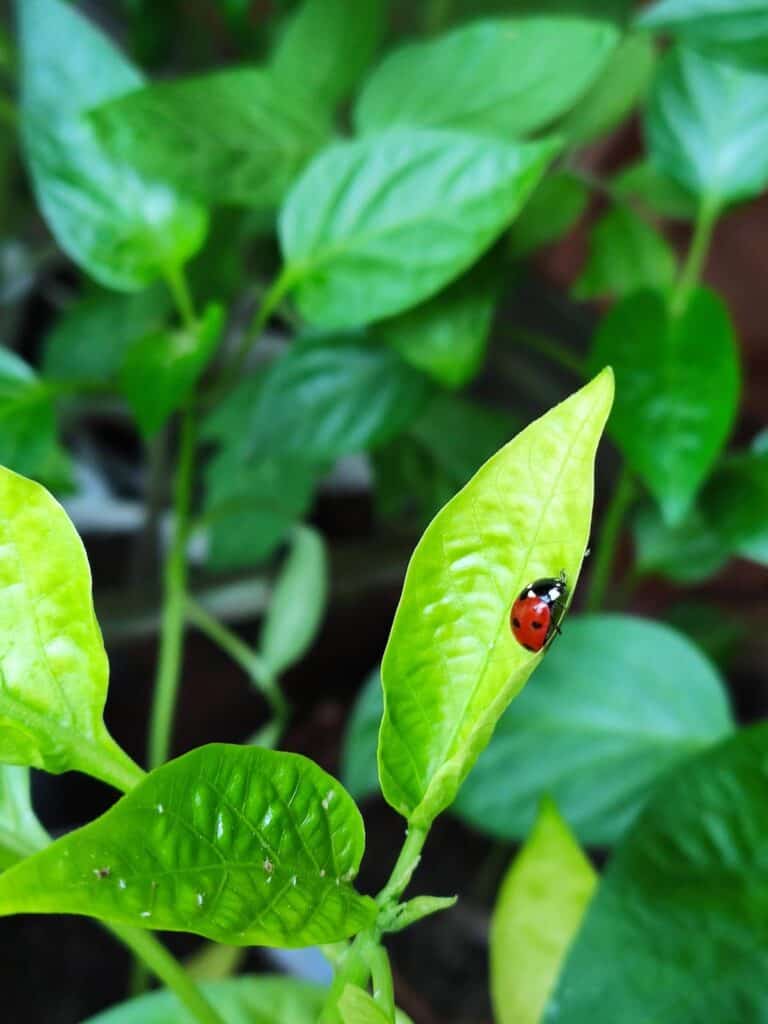What makes chili peppers spicier? Myths and facts about growing hotter peppers
When you hear about the heat level of chili peppers, it’s always in a range. For example, jalapeños commonly range from 2,500 – 8,000 SHU. That means the spiciest jalapeño is more than 3x hotter than the mildest, which is a huge difference!
So how can hot pepper lovers ensure their chilis are as spicy as possible? It’s not all within your control, but here are some tips to ensure you get the hottest harvest possible.
What makes peppers spicy?
The first thing you need to understand is what makes peppers hot.
The heat in chili peppers comes from capsaicinoids, a group of chemicals that stimulate the pain receptors in your mouth. The most abundant capsaicinoid is capsaicin, found in the white pith tissue surrounding the pepper seeds. Contrary to popular belief, the seeds themselves do not contain much capsaicin. Capsaicin has no flavor or odor but stings the back of your palate and burns your tongue and mid-palate.
Choose your pepper variety wisely
Choosing the most suitable variety of chili pepper is the first step in growing a hot pepper. If you want an ultra-hot pepper, jalapeños probably aren’t what you’re looking for! Here is a breakdown of a few different peppers based on heat level:
- Mild peppers with little distinguishable heat (average SHU up to 2,500): bell peppers, candy cane peppers, Anaheim peppers
- Medium peppers that are noticeably spicy but comfortable for most people (average SHU between 2,501 – 10,000): jalapeños, Sandia hot peppers, Hungarian wax peppers
- Hot peppers that will definitely burn (average SHU between 10,001 – 300,000): habaneros, rocoto peppers, scotch bonnets
- Ultra-hot peppers only suitable for experienced spicy food lovers (average SHU 300,001+): Carolina reapers, chocolate ghost peppers, Butch T peppers
If you want a scorching pepper, make sure that you choose a hot or ultra-hot variety. Similarly, a medium heat level pepper might be appropriate if you want something with noticeable spice that isn’t overpowering.
However, suppose you’re limited in the type of pepper you can grow (for example, growing only what’s available as started seedlings from your local Lowe’s). In that case, you can make a few changes to your growing conditions that might yield spicier peppers.
Conditions for growing hotter peppers
Now that you have the basics covered, it’s time to focus on increasing the heat of your peppers. Here are some tips to help you get started:
To grow hot peppers, you need to ensure they grow in the right conditions. One way to increase the heat of your peppers is by subjecting them to stress. However, this should be done in moderation and not at the expense of the plant’s health.
Despite much research on hot peppers, trying to make your peppers spicier is not an exact science. Many studies contradict one another and provide contrary evidence, so you must experiment and see what works.
Here are some factors that may have an impact on the heat of your peppers:
Water
There is mixed evidence on whether stressing your plant by reducing water will make your peppers hotter. Research on Padrón peppers in Northwest Spain (Estrada et al., 1999) found that low water treatment increased the heat of the peppers, as did a study of three types of capsicum annum peppers in Taiwan (Sung et al., 2005).
However, a study of jalapeños in California showed the opposite (Kan-Rice, 2014), so water manipulation alone may not produce consistent results across all climates and pepper types.
Temperature
Most chili peppers, except capsicum pubescens, grow best in warm climates, with hotter peppers thriving in hot weather. It is thought that warm nights specifically contribute to the success of hot peppers.
Insects
Capsaicin is produced at least in part to deter insects, so it’s possible that pest pressure can cause the pepper plant to produce higher levels of capsaicin. I haven’t found controlled studies showing causation, but ensuring a healthy ecosystem with all types of insects may benefit the heat of your peppers.
Nutrients (especially nitrogen)
Chili peppers require a balance of nutrients to grow properly. Too much nitrogen can result in lots of foliage but few fruits, while lacking nutrients can stunt the plant’s growth.
Contrary to popular advice, research indicates that providing adequate nitrogen helps peppers not only grow abundantly but may also help them grow hotter.
One study of habaneros showed that nitrogen fertilization increased plant growth and capsaicin concentration (Medina-Lara et al., 2008), while potassium fertilization did not have the same effect. A study of hydroponically grown habaneros showed that low nitrates caused lower levels of capsaicin, meaning peppers that were less hot (Monforte-González et al., 2010).
Supplementing your plants with compost and/or nitrogen and potassium fertilizers will give you an abundant and hotter harvest than trying to stress your plants by withholding nutrients.
Location on the plant
Even peppers from the exact same plant will vary in heat. The hottest peppers tend to be grown from the second node on the plant (Uatorra et al., 2020). This is likely because the plant puts more energy into the first few fruits it produces.
Maturity of the pepper
Common advice is that the more mature the pepper, the hotter it will be. However, research doesn’t support that claim.
A study of cayenne peppers showed that capsaicin content increased for the first 40 days of ripening and then decreased by 30% over the following ten days (Barbero et al., 2014). Another study examining habaneros, chiles de arbol, and piquin peppers found that peak capsaicin occurred between 40-55 days of maturity and then declined (Contreras-Padilla & Yahia, 1998).
Breeding hotter peppers over generations
If your goal in growing hotter peppers is to breed a hotter strain, cross-pollination is also essential to keep in mind.
Your peppers will not cross-pollinate and produce hybrid fruits in a single season, but if your goal is to save seeds for next year, cross-pollination should be a concern if you grow a variety of peppers within a small space.
Peppers are usually self-pollinating, but if you grow a variety of hot and sweet peppers close together, cross-pollination can occur. The resulting seeds may produce peppers with less heat in future generations. If saving seeds is your goal, isolate your peppers by planting them at least 500 feet apart to prevent cross-pollination.
So, how do you make peppers hotter?
At the end of all of this, there is still no single clear answer to how to make peppers hotter. However, here’s a summary of what we’ve learned:
- Water stress may help make peppers hotter under some circumstances, so you may want to try watering less often.
- Nitrogen fertilization, in most situations, seems to help increase peppers’ heat while ensuring a large harvest.
- Location on the plant might matter, with peppers on the second node being hotter than others.
- Picking peppers at around 40-50 days of maturity should yield the highest concentration of capsaicin while allowing them to mature longer than that will cause decreases of up to 30% or more.
- In a single season, you don’t need to worry about your sweet and hot peppers cross-pollinating and growing milder peppers; however, if you are trying to breed a new hot pepper, make sure your hot peppers are isolated.
Growing hotter chili peppers requires the right conditions, a little experimentation, and a whole lot of patience. By choosing the right variety, providing the right conditions, and subjecting your plants to the right kinds of stress, you can grow the spiciest peppers in your garden. Remember to start slowly and pay attention to your plants to ensure they are healthy and happy. Happy growing!
References:
- Barbero, G. F., Ruiz, A. G., Liazid, A., Palma, M., Vera, J. C., & Barroso, C. G. (2014). Evolution of total and individual capsaicinoids in peppers during ripening of the Cayenne pepper plant (capsicum annuum L.). Food Chemistry, 153, 200–206. https://doi.org/10.1016/j.foodchem.2013.12.068
- Contreras-Padilla, M., & Yahia, E. M. (1998). Changes in capsaicinoids during development, maturation, and senescence of Chile Peppers and relation with peroxidase activity. Journal of Agricultural and Food Chemistry, 46(6), 2075–2079. https://doi.org/10.1021/jf970972z
- Estrada, B., Pomar, F., Dı́az J, Merino, F., & Bernal, M. A. (1999). Pungency level in fruits of the Padrón Pepper with different water supply. Scientia Horticulturae, 81(4), 385–396. https://doi.org/10.1016/s0304-4238(99)00029-1
- Kan-Rice, P. (2014, October 14). Some like it hotter: UC Cooperative Extension tries to grow a Spicier Jalapeño. ANR Blogs. Retrieved April 24, 2023, from https://ucanr.edu/blogs/blogcore/postdetail.cfm?postnum=15571
- Medina-Lara, F., Echevarría-Machado, I., Pacheco-Arjona, R., Ruiz-Lau, N., Guzmán-Antonio, A., & Martinez-Estevez, M. (2008). Influence of nitrogen and potassium fertilization on fruiting and capsaicin content in habanero pepper (capsicum Chinense Jacq.). HortScience, 43(5), 1549–1554. https://doi.org/10.21273/hortsci.43.5.1549
- Monforte-González, M., Guzmán-Antonio, A., Uuh-Chim, F., & Vázquez-Flota, F. (2010). Capsaicin accumulation is related to nitrate content in placentas of Habanero Peppers (capsicum chinense jacq.). Journal of the Science of Food and Agriculture, 90(5), 764–768. https://doi.org/10.1002/jsfa.3880
- Sung, Y., Chang, Y.-Y., & Ting, N.-L. (2005). Capsaicin biosynthesis in water-stressed hot pepper fruits. Botanical Bulletin of Academia Sinica, 46.
- Uarrota, V. G., Maraschin, M., de Bairros, Â. de, & Pedreschi, R. (2020). Factors affecting the capsaicinoid profile of hot peppers and biological activity of their non-pungent analogs (capsinoids) present in Sweet Peppers. Critical Reviews in Food Science and Nutrition, 61(4), 649–665. https://doi.org/10.1080/10408398.2020.1743642






